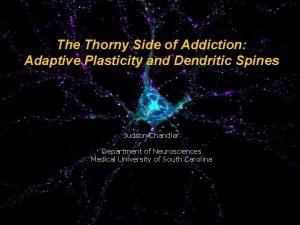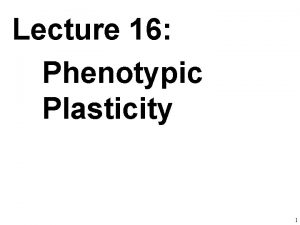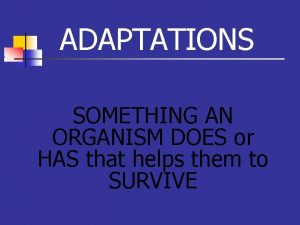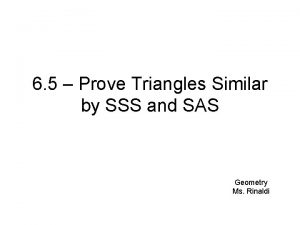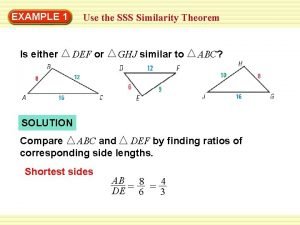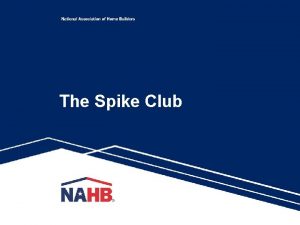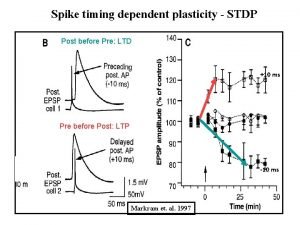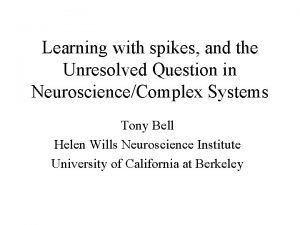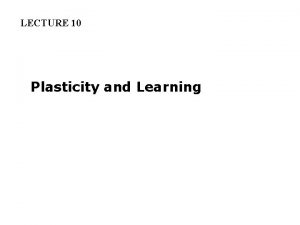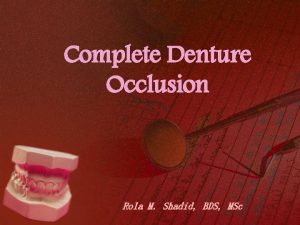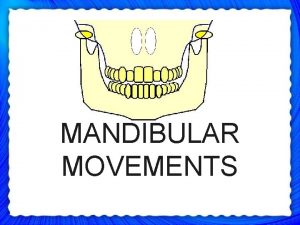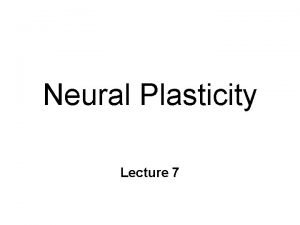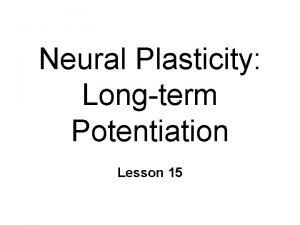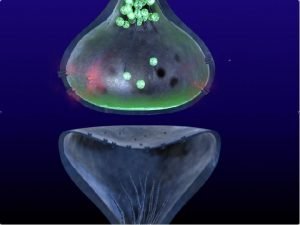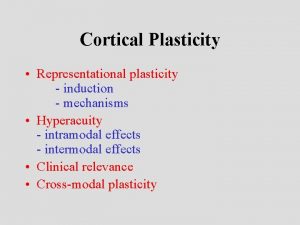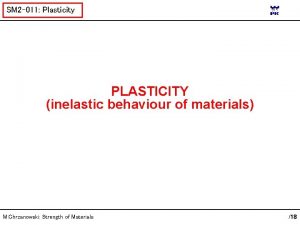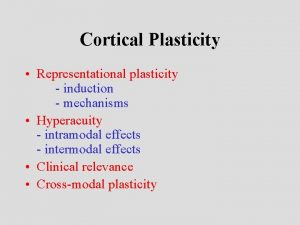The Thorny Side of Addiction Adaptive Plasticity and



















- Slides: 19

The Thorny Side of Addiction: Adaptive Plasticity and Dendritic Spines Judson Chandler Department of Neurosciences Medical University of South Carolina

Peter W Kalivas and Charles O’Brien

NMDA Receptors: Subunits and membrane trafficking

Alcohol Tolerance and Homeostatic Plasticity Normal balance Inhibitory Excitatory GABAergic Glutamatergic Et. OH Acute ethanol (Instability of neuronal circuits) Et. OH Prolonged ethanol Et. OH (Homeostatic plasticity restores stability to neuronal circuits; underlies tolerance development) Et. OH Ethanol withdrawal (Hyper-excitability; promotes aberrant plasticity)

In Vitro Model of Chronic Alcohol Exposure Primary rat hippocampal neurons Used for experimentation when fully mature (2 -3 weeks in vitro) Chronic ethanol exposure in sealed vapor chambers Evaluated by IHC/confocal imaging & electrophysiology

Size NR 1 syn overlay 16 NR 1 Cluster Size (# Pixels/Cluster) Control 14 6 4 2 Synaptic Extrasynaptic overlay Density # NR 1 Cluster/10 µM syn Control Et. OH+NMDA 8 NR 1 # 12 10 0 Et. OH * 12 * Control Et. OH+NMDA 10 8 6 4 2 0 *# Synaptic Extrasynaptic

Et. OH 20 NR 2 B Cluster Size (# Pixels/Cluster) 18 NR 2 B * Size Density 12 Control Et. OH 16 14 12 10 * 8 6 4 2 0 Synaptic Extrasynaptic * 10 Et. OH 6 * 4 2 0 Synaptic Colocalization 100 90 80 70 60 50 40 30 20 10 0 Control Extrasynaptic Size 14 12 10 8 6 4 2 0 Ethanol Control 8 Glu. R 1 Cluster Size (# pixels/cluster Glu. R 1 Et. OH Percent Colocalization Control # NR 2 B Clusters/10 µm Control Ethanol

Et. OH 1000 Amplitude, p. A 20 18 16 14 12 10 8 6 4 2 0 Control 250 0. 1 0 0. 0 Amplitude Et. OH Withdrawn Frequency Extrasynaptic NMDA Currents * Control 0. 3 0. 2 Current, p. A/p. F NMDA/AMPA Current Ratio 1. 0 0. 9 0. 8 0. 7 0. 6 0. 5 0. 4 0. 3 0. 2 0. 1 0. 0 0. 4 500 Amplitude Frequency NMDA m. EPSC * 750 Control Et. OH * 60 40 20 Control Et. OH 0 10 -6 10 -5 10 -4 10 -3 [NMDA], M Frequency, Hz 20 18 16 14 12 10 8 6 4 2 0 Spontaneous NMDA EPSC Frequency, Hz Amplitude, p. A AMPA m. EPSC

Summary of findings • Prolonged ethanol exposure results in the enhancement of NR 2 B-containing NMDA receptors selectively at the synapse. • No changes in AMPA receptors. • Activity and PKA-dependent. • Slowly reverses upon ethanol removal. • Electrophysiological observations correlated with confocal image analysis confirming functional plasticity. Is there a corresponding structural component of this homeostatic response to chronic alcohol exposure?

Dendritic Spines and Structural Plasticity Phalloidin stained F-actin Actin/NR 1 Matus, Science 290: 754, 2000

Control ** % Neurons with large spines Et. OH actin ** @ * Et. OH (m. M) ** Actin Size * ## Et. OH+ NMDA # F-actin Clusters/10 u. M Et. OH F-Actin Clusters (# pixels. cluster) Con Et. OH+ NMDA * Density # * Et. OH+ NMDA

Control Et. OH NMDA Et. OH+ NMDA PSD-95/synapsin Et. OH * # Synaptic Extrasynaptic #PSD-95 Clusters/10 u. M PSD-95 Cluster Size (# pixels/cluster) Size * Density # Synaptic * # Extrasynaptic

Control Et. OH * F-Actin/PSD-95 % colocalization Actin PSD-95 2 um Control Et. OH F-Actin Cluster Size (# pixels/cluster) # F-Actin Clusters/10 u. M ** Density Size With PSD-95 Without PSD-95 ** With PSD-95 Without PSD-95

Control # pixels/cluster Actin PSD-95 Control Et. OH 50 45 40 35 30 25 20 15 10 5 0 ** Size # Cont Et. OH 2 Pal Et. OH+2 Pal 2 um # clusters/10 um 2 Pal 9 8 7 6 5 4 3 2 1 0 * Density ** # Cont Et. OH 2 Pal Et. OH+ 2 Pal

Control Et. OH 2 Pal Et. OH +2 Pal Density * Control Et. OH 2 Pal Et. OH + 2 Pal ## NR 1/synapsin Synaptic Extrasynaptic

Molecular model of ethanol-induce plasticity Chronic activity blockade Spine enlargement Actin cycling NR 2 B PSD-95 NR 2 B NR 2 A PSD-95 recruitment PSD Signaling Complex “learning spines” (more plastic, but less stable) PSD Signaling Complex Repeated Et. OH exposure and withdrawal experiences “memory spines” (more stable, but less plastic)

recruitment PSD Signaling Complex NMDA/AMPA ratio • Does this model have in vivo validity? 0. 6 0. 5 0. 4 0. 3 0. 2 0. 1 0. 0 * Control Ethanol • How do these homeostatic changes impact synaptic plasticity in the context of the addiction neurocircuitry? Everitt and Robbins, 2005

Chronic Ethanol-induced Plasticity versus Toxicity Novel object recognition

Acknowledgements Ezekiel Carpenter-Hyland Nick Luong Patrick Mulholland John Woodward Sven Kroener Howard Becker Kenneth Abernathy Luca Pellicoro Jeremy Seamans Chris Lapish NIAAA NIH ABMRF
 Becker
Becker Adaptive plasticity
Adaptive plasticity Thorny devil
Thorny devil Side side side similarity theorem
Side side side similarity theorem Similar picture
Similar picture Sss similarity theorem examples
Sss similarity theorem examples Triangle similarity theorems
Triangle similarity theorems Unto us spike milligan
Unto us spike milligan Spike timing dependent plasticity
Spike timing dependent plasticity Spike timing dependent plasticity
Spike timing dependent plasticity Liquid limit flow curve
Liquid limit flow curve Basalt
Basalt Plasticity
Plasticity Plasticity in earth's layers
Plasticity in earth's layers Lingual occlusion
Lingual occlusion Year 9 trigonometry
Year 9 trigonometry What is server side programming
What is server side programming Horizontal
Horizontal Perfect competition side by side graphs
Perfect competition side by side graphs Uil side by side
Uil side by side
